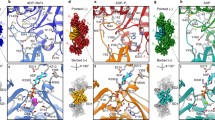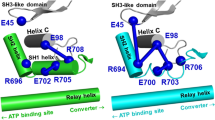Abstract
Nucleotide and actin binding properties of the truncated myosin head (S1dC) from Dictyostelium myosin II were studied in solution using rabbit skeletal myosin subfragment 1 as a reference material. S1dC and subfragment 1 had similar affinities for ADP analogues, ɛADP and TNP-ADP. The complexes of ɛADP and BeFx or AlF4 - were less stable with S1dC than with subfragment 1. Stern-Volmer constants for acrylamide quenching of S1dC complexes with ɛADP, ɛADP·AlF -4 and ɛADP.BeFx were 2.6, 2.9 and 2.2 M-1, respectively. The corresponding values for subfragment 1 were 2.6, 1.5 and 1.1 M-1. The environment of the nucleotide binding site was probed by using a hydrophobic fluorescent probe, PPBA. PPBA was a competitive inhibitor of S1dC Ca2+-ATPase (Ki = 1.6 μm). The binding of nucleotides to subfragment 1 enhanced PPBA fluorescence and caused blue shifts in the wavelength of its maximum emission in the order: ATP ≈ ADP·AlF4- ≈ ADP·BeFx > ATPSγS > ADP > PPi. In the case of S1dC, the effects of different nucleotides were smaller and indistinguishable from each other. S1dC bound actin tighter than S1 (Kd = 7 nm and 60 nm, respectively). The actin activated MgATPase activity of S1dC varied between preparations, and the Vmax and Km values ranged between 3 and 7 s-1 and 60 and 190 μm, respectively. S1dC showed lower structural stability than S1 as revealed by their thermal inactivations at 35° C. These results show that the nucleotide and actin binding of S1dC and subfragment 1 are similar but there are some differences in nucleotide and phosphate analogue-induced changes and the communication between the nucleotide and actin binding sites in these proteins
Similar content being viewed by others
References
APPLEGATE & REISLER (1984) Protease sensitive regions in myosin subfragment 1. Biochemistry23, 4779–84.
BIVIN, D. B., UE, K., KHOROSHEV, M. & MORALES, M. F. (1994) Effect of lysine methylation and other ATPase modulators on the active site of myosin subfragment 1. Proc. Natl. Acad. Sci. USA91, 8665–9.
BOBKOV, A. A., KHVOROV, N. V., GOLITSINA, N. L. & LEVITSKY, D. I. (1993) Calorimetric characterization of the stable complexes of myosin subfragment 1 with ADP and beryllium fluoride. FEBS Lett.332, 64–6.
BRADFORD, M. M. (1976) A rapid and sensitive method for the quantitation of microgram quantities of protein utilizing the principle of protein-dye binding. Anal. Biochem.72, 248–54.
COOPER, J. A., WALKER, S. B. & POLLARD, T. D. (1983) Pyren actin: documentation of the validity of a sensitive assay for actin polymerization. J. Mus. Res. Cell Motil.4, 253–62.
FISHER, A. J., SMITH, C. A., THODEN, J. B., SMITH, R., SUTOH, K., HOLDEN, H. M. & RAYMENT, I. (1995) X-ray structures of the myosin motor domain of Dictyostelium discoideum complexed with MgADP-BeFx and MgADP-AlF4– Biochemistry34, 8960–72.
GEEVES, M. A. & JEFFRIES, T. E. (1988) The effect of nucleotide upon a specific isomerization of actomyosin subfragment 1. Biochem. J.256, 41–6.
GEEVES, M., KURZAWA, S., HUNT, D. & MANSTEIN, D. (1996) Kinetic characterisation of different length fragments of the myosin head expressed in Dictyostelium discoideum. Biophys. J.70, n. 2, part 2, a267.
GODFREY, J. & HARRINGTON, W. F. (1970) Self-association in the myosin system at high ionic strength. I. Sensitivity of the interaction to pH and ionic environment. Biochemistry9, 886–93.
HIRATSUKA, T. (1982) Biological activities and spectroscopic properties of chromophoric and fluorescent analogs of adenine nucleoside and nucleotides, 2′,3′-O-(2,4,6-trinitrocyclohexadienylidene) adenosine derivatives. Biochim. Biophsy. Acta. 719, 509–17.
HIRATSUKA, T. (1990) Transmission of ADP-vanadate-induced conformational changes to three peptide segments of myosin subfragment-1. J. Biol. Chem.265, 18791–6.
HIRATSUKA, T. (1994) Nucleotide-induced closure of the ATP-binding pocket in myosin subfragment-1. J. Biol. Chem.269, 27251–7.
ITAKURA, S. I., YAMAKAWA, H., TOYOSHIMA, Y. Y., ISHIJIMA, A., KOJIMA, T., HARADA, Y., YANAGIDA, T., WAKABAYASHI, T. & SUTOH, K. (1993) Force-generating domain of myosin motor. Biochem. Biophs. Res. Commun.196, 1504–10.
KODAMA, T., FUKUI, K. & KOMETANI, K. (1986) The initial phosphate burst in ATP hydrolysis by myosin and subfragment-1 studied by modified Malachite Green method for determination of inorganic phosphate. J. Biochem.99, 1465–72.
KOUYAMA, T. & MIHASHI, K. (1981) Fluorimetry study of N-(1-pyrenyl)iodacetamide-labelled F-actin. Eur. J. Biochem.114, 33–8.
LEVITSKY, D. I., PONOMAREV, M. A., GEEVES, M. A., NIKOLAEVA, O. P. & MANSTEIN, D. J. (1997) Calorimetric characterisation of the motor domain of Dictyostelium discoideum myosin, J. Muscle. Res. Cell. Motil, in press.
LYMN, R. W. & TAYLOR, E. W. (1970) Transient state phosphate production in the hydrolysis of nucleoside triphosphates by myosin. Biochemistry9, 2975–83.
MA, Y.-Z. & TAYLOR, E. W. (1994) Kinetic mechanism of myofibril ATPase. Biophys. J.66, 1542–53.
MOCZ, G., SZILAGYI, L., CHEN LU, K., FABIAN, F., BALINT, M. & GERGELY, J. (1984) Effect of nucleotides, divalent cations and temperature on the tryptic susceptibility of myosin subfragment 1. J. Biochem.145, 221–9.
MORNET, D., PANTEL, P., AUDEMARD, E., DERANCOURT, J. & KASSAB, R. (1985) Molecular movements promoted by metal nucleotides in the heavy-chain regions of myosin heads from skeletal muscle. J. Mol. Biol.183, 479–89.
PHAN, B. C., CHEUNG, P. STAFFORD, W. F. & REISLER, E. (1996) Complexes of myosin subfragment-1 with adenosine diphosphate and phosphate analogs: probes of active site and protein conformation. Biophys. Chem.59, 341–9.
RAYMENT, I., RYPNIEWSKY, W. R., SCHMIDT-BASE, K., SMITH, R., TOMCHIK, D. R., BENNIG, M. M., WINKELMANN, D. A., WESENBERG, G. & HOLDEN, H. M. (1993) Three-dimensional structure of myosin subfragment-1: a molecular motor. Science261, 51–8.
RITCHIE, M. D., GEEVES, M. A., WOODWARD, S. K. A. & MANSTEIN, D. J. (1993) Kinetic characterization of a cytoplasmic myosin motor domain expressed in Dictyostelium discoideum. Proc. Natl. Acad. Sci. USA90, 8619–23.
ROSENFELD, S. S. & TAYLOR, E. W. (1984) Reactions of 1-N6-ethenoadenosine nucleotides with myosin subfragment 1 and acto-subfragment 1 of skeletal and smooth muscle. J. Biol. Chem.259, 11920–9.
SPUDICH, J. A. & WATT, S. (1971) Regulation of skeletal muscle contraction. I. Biochemical studies of the interaction of the tropomysin-troponin complex with actin and the proteolytic fragments of myosin. J. Biol. Chem.246, 4866–76.
TRUONG, T., MEDLEY, Q. G. & COTE, G. P. (1992) Actin-activated Mg-ATPase activity of Dictyostelium myosin II. J. Biol. Chem.267, 9767–72.
WALLER, G. S., OUYANG, G., SWAFFORD, J., VIBERT, P. & LOWEY, S. (1995) Minimal motor domain from chicken skeletal muscle myosin. J. Biol. Chem.270, 15348–52.
WEEDS, A. G. & POPE, B. (1977) Studies on the chymotryptic digestion of myosin. Effect of divalent cations on proteolytic susceptibility. J. Mol. Biol.111, 129–57.
WERBER, M. M., SZENT-GYORGYI, A. G. & FASMAN, G. D. (1972) Fluorescence studies on heavy meromyosin — substrate interaction. Biochemistry11, 2872–82.
WOODWARD, S. K. A., GEEVES, M. A. & MANSTEIN, D. J. (1995) Kinetic characterization of the catalytic domain of Dictyostelium discoideum myosin. Biochemistry34, 16056–64.
Author information
Authors and Affiliations
Rights and permissions
About this article
Cite this article
Bobkov, A.A., Sutoh, K. & Reisler, E. Nucleotide and actin binding properties of the isolated motor domain from Dictyostelium discoideum myosin. J Muscle Res Cell Motil 18, 563–571 (1997). https://doi.org/10.1023/A:1018667319386
Issue Date:
DOI: https://doi.org/10.1023/A:1018667319386




